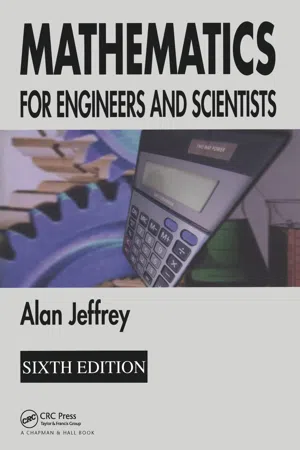
- 1,016 pages
- English
- ePUB (mobile friendly)
- Available on iOS & Android
eBook - ePub
Mathematics for Engineers and Scientists
About this book
Since its original publication in 1969, Mathematics for Engineers and Scientists has built a solid foundation in mathematics for legions of undergraduate science and engineering students. It continues to do so, but as the influence of computers has grown and syllabi have evolved, once again the time has come for a new edition.
Thoroughly rev
Frequently asked questions
Yes, you can cancel anytime from the Subscription tab in your account settings on the Perlego website. Your subscription will stay active until the end of your current billing period. Learn how to cancel your subscription.
No, books cannot be downloaded as external files, such as PDFs, for use outside of Perlego. However, you can download books within the Perlego app for offline reading on mobile or tablet. Learn more here.
Perlego offers two plans: Essential and Complete
- Essential is ideal for learners and professionals who enjoy exploring a wide range of subjects. Access the Essential Library with 800,000+ trusted titles and best-sellers across business, personal growth, and the humanities. Includes unlimited reading time and Standard Read Aloud voice.
- Complete: Perfect for advanced learners and researchers needing full, unrestricted access. Unlock 1.4M+ books across hundreds of subjects, including academic and specialized titles. The Complete Plan also includes advanced features like Premium Read Aloud and Research Assistant.
We are an online textbook subscription service, where you can get access to an entire online library for less than the price of a single book per month. With over 1 million books across 1000+ topics, we’ve got you covered! Learn more here.
Look out for the read-aloud symbol on your next book to see if you can listen to it. The read-aloud tool reads text aloud for you, highlighting the text as it is being read. You can pause it, speed it up and slow it down. Learn more here.
Yes! You can use the Perlego app on both iOS or Android devices to read anytime, anywhere — even offline. Perfect for commutes or when you’re on the go.
Please note we cannot support devices running on iOS 13 and Android 7 or earlier. Learn more about using the app.
Please note we cannot support devices running on iOS 13 and Android 7 or earlier. Learn more about using the app.
Yes, you can access Mathematics for Engineers and Scientists by Alan Jeffrey in PDF and/or ePUB format, as well as other popular books in Mathematics & Applied Mathematics. We have over one million books available in our catalogue for you to explore.
Information
1 | Numbers, trigonometric functions and coordinate geometry |
The topics reviewed in this chapter represent the essential mathematical prerequisites necessary for a proper understanding of the remainder of the book. Applications of these underlying concepts arise repeatedly, and in many different contexts. The material covered is necessarily of a somewhat diverse nature and not all of it is closely related.
The chapter starts with an account of the real number system, together with its arithmetic laws and their consequences, because these represent the basis for the development of the theory of functions of one or more real variables. Inequalities are introduced because they serve both to define intervals on a line and regions in space when working with functions and, also in connection with functions, to make precise the meaning of analytical concepts like limit and continuity.
The technique of mathematical induction is included because it finds applications throughout mathematics. It enables a conjecture concerning the form taken by a general mathematical proposition depending on an integer n to be tested and found to be either true or false. Thus, for example, mathematical induction can be used to verify or reject an expression for the form taken by the general term in a series that has been found by observing the pattern of a few successive terms, to check the correctness of a closed-form expression for the sum of a finite numerical series that has been arrived at intuitively, or to prove the binomial theorem.
Trigonometric functions and their associated identities are reviewed because they belong to the group of elementary functions on which most of mathematics is based, and because of the need to use their properties in most chapters of the book.
A knowledge of the elements of rectangular Cartesian coordinate geometry and of polar coordinates is essential for an understanding of the geometrical implications of many properties of functions, and also for applications of mathematics to physical problems. Discussions of the effect of a rotation or a shift of origin on a coordinate system, and of a transformation from Cartesian to polar coordinates, are included because changes of this type often simplify problem...
Table of contents
- Cover
- Half Title
- Title Page
- Copyright Page
- Table of Contents
- Preface to the sixth edition
- 1 Numbers, trigonometric functions and coordinate geometry
- 2 Variables, functions and mappings
- 3 Sequences, limits and continuity
- 4 Complex numbers and vectors
- 5 Differentiation of functions of one or more real variables
- 6 Exponential, logarithmic and hyperbolic functions and an introduction to complex functions
- 7 Fundamentals of integration
- 8 Systematic integration
- 9 Double integrals in Cartesian and plane polar coordinates 439
- 10 Matrices and linear transformations
- 11 Scalars, vectors and fields
- 12 Series, Taylor’s theorem and its uses
- 13 Differential equations and geometry
- 14 First-order differential equations
- 15 Higher-order linear differential equations
- 16 Fourier series
- 17 Numerical analysis
- 18 Probability and statistics
- 19 Symbolic algebraic manipulation by computer software
- Answers
- Reference list 1: Useful identities and constants
- Reference list 2: Basic derivaties and rules
- Reference list 3: Laplace transform pairs
- Reference list 4: Short table of integrals
- Index